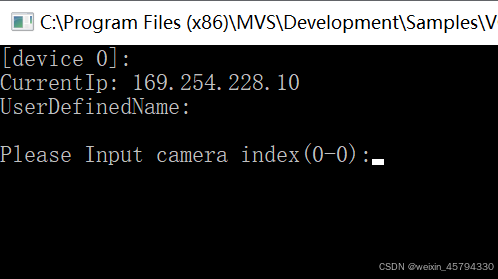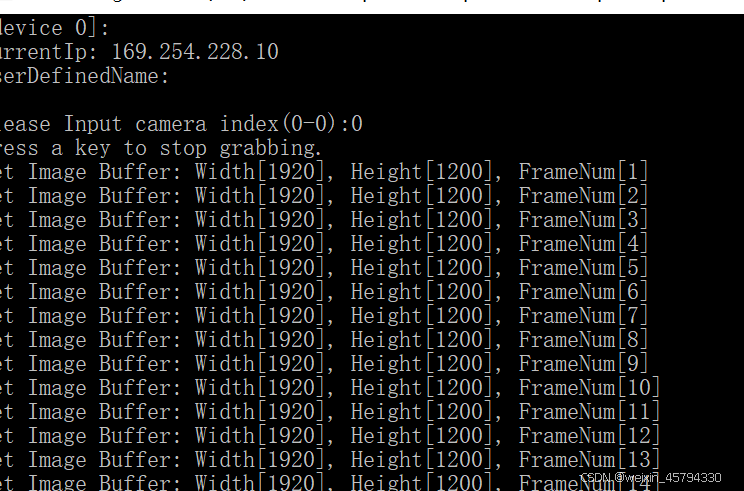阅读量:1
#include <stdio.h> #include <Windows.h> #include <process.h> #include <conio.h> #include "MvCameraControl.h" bool g_bExit = false; // ch:等待按键输入 | en:Wait for key press void WaitForKeyPress(void) { while(!_kbhit()) { Sleep(10); } _getch(); } //相机参数 bool PrintDeviceInfo(MV_CC_DEVICE_INFO* pstMVDevInfo) { if (NULL == pstMVDevInfo) { printf("The Pointer of pstMVDevInfo is NULL!\n"); return false; } if (pstMVDevInfo->nTLayerType == MV_GIGE_DEVICE) { int nIp1 = ((pstMVDevInfo->SpecialInfo.stGigEInfo.nCurrentIp & 0xff000000) >> 24); int nIp2 = ((pstMVDevInfo->SpecialInfo.stGigEInfo.nCurrentIp & 0x00ff0000) >> 16); int nIp3 = ((pstMVDevInfo->SpecialInfo.stGigEInfo.nCurrentIp & 0x0000ff00) >> 8); int nIp4 = (pstMVDevInfo->SpecialInfo.stGigEInfo.nCurrentIp & 0x000000ff); // ch:打印当前相机ip和用户自定义名字 | en:print current ip and user defined name printf("CurrentIp: %d.%d.%d.%d\n" , nIp1, nIp2, nIp3, nIp4); printf("UserDefinedName: %s\n\n" , pstMVDevInfo->SpecialInfo.stGigEInfo.chUserDefinedName); } else if (pstMVDevInfo->nTLayerType == MV_USB_DEVICE) { printf("UserDefinedName: %s\n", pstMVDevInfo->SpecialInfo.stUsb3VInfo.chUserDefinedName); printf("Serial Number: %s\n", pstMVDevInfo->SpecialInfo.stUsb3VInfo.chSerialNumber); printf("Device Number: %d\n\n", pstMVDevInfo->SpecialInfo.stUsb3VInfo.nDeviceNumber); } else { printf("Not support.\n"); } return true; } static unsigned int __stdcall WorkThread(void* pUser) { int nRet = MV_OK; MV_FRAME_OUT stOutFrame = {0}; MV_DISPLAY_FRAME_INFO stDisplayInfo = { 0 }; MV_DISPLAY_FRAME_INFO 成员变量 //void * hWnd //窗口句柄 //unsigned char * pData //显示的数据 //unsigned int nDataLen//数据长度 //unsigned short nWidth//图像宽 //unsigned short nHeight//图像高 //enum MvGvspPixelType enPixelType//像素格式 //unsigned int nRes[4]//保留 HWND g_hwnd = GetForegroundWindow();//获取当前DOS窗口句柄 while(true) { nRet = MV_CC_GetImageBuffer(pUser, &stOutFrame, 1000); if (nRet == MV_OK) { printf("Get Image Buffer: Width[%d], Height[%d], FrameNum[%d]\n", stOutFrame.stFrameInfo.nWidth, stOutFrame.stFrameInfo.nHeight, stOutFrame.stFrameInfo.nFrameNum); //将图片显示在DOS窗口上 if (g_hwnd) { stDisplayInfo.hWnd = g_hwnd; stDisplayInfo.pData = stOutFrame.pBufAddr;// 指向图像数据的指针 stDisplayInfo.nDataLen = stOutFrame.stFrameInfo.nFrameLen;//数据长度 stDisplayInfo.nWidth = stOutFrame.stFrameInfo.nWidth; // 图像的宽度(像素) stDisplayInfo.nHeight = stOutFrame.stFrameInfo.nHeight; // 图像的高度(像素) stDisplayInfo.enPixelType = stOutFrame.stFrameInfo.enPixelType; // 像素类型,如黑白、RGB、Bayer等 MV_CC_DisplayOneFrame(pUser, &stDisplayInfo); } nRet = MV_CC_FreeImageBuffer(pUser, &stOutFrame); if(nRet != MV_OK) { printf("Free Image Buffer fail! nRet [0x%x]\n", nRet); } } else { printf("Get Image fail! nRet [0x%x]\n", nRet); } if(g_bExit) { break; } } return 0; } int main() { int nRet = MV_OK; void* handle = NULL; do { // ch:枚举设备 | en:Enum device MV_CC_DEVICE_INFO_LIST stDeviceList; memset(&stDeviceList, 0, sizeof(MV_CC_DEVICE_INFO_LIST)); nRet = MV_CC_EnumDevices(MV_GIGE_DEVICE | MV_USB_DEVICE, &stDeviceList); if (MV_OK != nRet) { printf("Enum Devices fail! nRet [0x%x]\n", nRet); break; } if (stDeviceList.nDeviceNum > 0) { for (unsigned int i = 0; i < stDeviceList.nDeviceNum; i++) { printf("[device %d]:\n", i); MV_CC_DEVICE_INFO* pDeviceInfo = stDeviceList.pDeviceInfo[i]; if (NULL == pDeviceInfo) { break; } PrintDeviceInfo(pDeviceInfo); } } else { printf("Find No Devices!\n"); break; } printf("Please Input camera index(0-%d):", stDeviceList.nDeviceNum-1); unsigned int nIndex = 0; scanf_s("%d", &nIndex); if (nIndex >= stDeviceList.nDeviceNum) { printf("Input error!\n"); break; } // ch:选择设备并创建句柄 | en:Select device and create handle nRet = MV_CC_CreateHandle(&handle, stDeviceList.pDeviceInfo[nIndex]); if (MV_OK != nRet) { printf("Create Handle fail! nRet [0x%x]\n", nRet); break; } // ch:打开设备 | en:Open device nRet = MV_CC_OpenDevice(handle); if (MV_OK != nRet) { printf("Open Device fail! nRet [0x%x]\n", nRet); break; } // ch:探测网络最佳包大小(只对GigE相机有效) | en:Detection network optimal package size(It only works for the GigE camera) if (stDeviceList.pDeviceInfo[nIndex]->nTLayerType == MV_GIGE_DEVICE) { int nPacketSize = MV_CC_GetOptimalPacketSize(handle); if (nPacketSize > 0) { nRet = MV_CC_SetIntValue(handle,"GevSCPSPacketSize",nPacketSize); if(nRet != MV_OK) { printf("Warning: Set Packet Size fail nRet [0x%x]!", nRet); } } else { printf("Warning: Get Packet Size fail nRet [0x%x]!", nPacketSize); } } // ch:设置触发模式为off | en:Set trigger mode as off nRet = MV_CC_SetEnumValue(handle, "TriggerMode", 0); if (MV_OK != nRet) { printf("Set Trigger Mode fail! nRet [0x%x]\n", nRet); break; } // ch:开始取流 | en:Start grab image nRet = MV_CC_StartGrabbing(handle); if (MV_OK != nRet) { printf("Start Grabbing fail! nRet [0x%x]\n", nRet); break; } unsigned int nThreadID = 0; void* hThreadHandle = (void*) _beginthreadex( NULL , 0 , WorkThread , handle, 0 , &nThreadID ); if (NULL == hThreadHandle) { break; } //在C/C++编程中,_beginthreadex 是一个用于在Microsoft Visual Studio环境下创建线程的函数。 //这个函数定义在<process.h>头文件中,它允许你在一个独立的线程中启动一个新的执行路径。下面是对给定代码行的解释: //NULL:这是线程属性指针,通常设置为NULL表示使用默认属性。 //0:这是线程堆栈大小。如果设置为0,那么系统会根据默认值或编译器设置来决定堆栈大小。 //WorkThread:这是指向线程函数的指针,当线程开始运行时,将从这里开始执行。 //handle:这是传递给WorkThread函数的参数。当WorkThread被调用时,它的第一个参数将接收这个值。 //0:这是线程的优先级增量。通常设置为0,意味着线程将具有默认的优先级。 //&nThreadID:这是一个指向整型变量的指针,_beginthreadex函数将返回创建的新线程的ID到这个变量中。 printf("Press a key to stop grabbing.\n"); WaitForKeyPress(); g_bExit = true; Sleep(1000); // ch:停止取流 | en:Stop grab image nRet = MV_CC_StopGrabbing(handle); if (MV_OK != nRet) { printf("Stop Grabbing fail! nRet [0x%x]\n", nRet); break; } // ch:关闭设备 | Close device nRet = MV_CC_CloseDevice(handle); if (MV_OK != nRet) { printf("ClosDevice fail! nRet [0x%x]\n", nRet); break; } // ch:销毁句柄 | Destroy handle nRet = MV_CC_DestroyHandle(handle); if (MV_OK != nRet) { printf("Destroy Handle fail! nRet [0x%x]\n", nRet); break; } } while (0); if (nRet != MV_OK) { if (handle != NULL) { MV_CC_DestroyHandle(handle); handle = NULL; } } printf("Press a key to exit.\n"); WaitForKeyPress(); return 0; }

本代码将会把工业相机拍摄图像显示在DOS窗体上
本文仅供学习交流,严禁用于商业用途,如本文涉及侵权请及时联系将于24小时内删除
